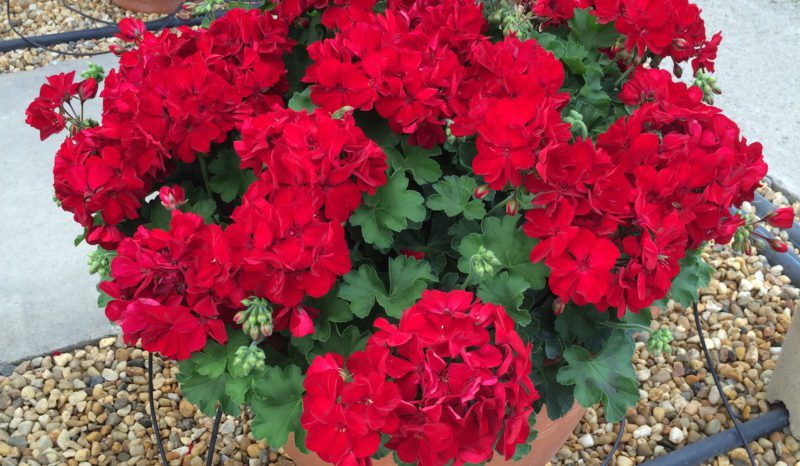
Culture Report: Geranium ‘Cassiopeia’
With its distinctively more compact and well-branched habit and smaller leaves, ‘Cassiopeia’ allows growers to produce plants in everything from 4-inch containers to hanging baskets with very reduced rates, if any, of plant growth regulators. Heat loving and drought tolerant, ‘Cassiopeia’ will perform reliably in even the hottest, driest summer conditions. ‘Cassiopeia’ features large double flowers in a rich, dark, velvet red, which bloom under full sun and partial shade conditions. Its superior branching fills containers quickly, providing a premium finished plant.
Propagation
Open the boxes immediately upon arrival to release built-up ethylene, which can be a problem for geraniums. Unrooted cuttings should be stuck immediately, but if necessary, they can be stored overnight at temperatures between 38 and 40oF with at least 70 percent relative humidity. A standard propagation media containing 65 percent peat and 35 percent perlite is ideal. The optimum pH medium should be maintained between 5.8 and 6.0. Rooting hormones are not recommended and can cause burn on stems, leading to plant losses.
In the first two days, keep the cuttings under mist with temperatures at 72o F to rehydrate the cuttings and regain full leaf expansion. A spray application of CapSil also can be used during the first two days to help cuttings rehydrate faster, while also preventing leaf damage from large water droplets. Misting should be done until the older leaves start rolling, but do not wilt. Do not over mist to the point of allowing standing water on the leaves.
After the first two days, night misting can be discontinued and temperatures lowered to 68o F. Callus should form seven days after sticking and mist can be significantly reduced at that time. Over misting throughout the rooting process may lead to foliage diseases.
When the first roots appear from the callus, a low application of 20-10-20 should be applied at a rate of 150 ppm. Optimum light levels through the propagation phase are between 2,000 and 2,600 foot-candles. Additionally, under bench heating will significantly shorten the propagation time.
It is important to practice a weekly fungicide/bactericide application to increase the success rate through propagation. A strong combination in the mist house environment is Danocil together with Chipco followed in rotation with Heritage, Zerotol and Compass O through the following weeks. Avoid the use of Medallion, as this has caused phytotoxicity in geraniums. Plants should additionally be given a fungicide drench of Subdue MAXX after roots develop to prevent Pythium root rot.
Finishing
Growing media and fertilizer. Interspecific geraniums prefer a slightly acidic media with a pH between 5.7 and 6.0. The ideal growing media should contain 70 percent peat to 30 percent perlite.
Shortly after transplant, feed plants consistently with a well-balanced 20-10-20 at 150-ppm nitrogen and increase rates to 250 ppm through the next six weeks as the crop finishes. Maintain EC levels in the potting media between 2.0 and 2.5.
Light. ‘Cassiopeia’ prefers a high light level around 4,000 foot-candles. Light levels above 4,000 foot-candles can cause leaf damage, specifically when combined with high temperatures and low humidity.
Watering practices. To avoid root damage or fungal infections, as well as nutrition deficiency, it is very important to maintain an even moisture level during the growing process. Low or very high water levels can disturb the water supply into the tissue and cause reduced growth, delay development and extend crop time as well as flowering.
Temperature. Moderately warm day temperatures around 75o F ensure healthy roots and consistent plant growth. Lower night temperatures of 60 to 65o F will ensure compact, well-branched plants. A negative differential strategy also can be used six weeks after transplant by lowering the greenhouse temperatures to 50o F for two hours before sunrise.
Grow time.
Propagation in 50 cell tray: five weeks
Finishing 4 inch: 10 to 11 weeks (1 ppp)
Finishing 6 inch: 14 weeks (1 ppp)
Finishing 12 inch: 12 to 14 weeks (5 ppp)
Pinching and growth regulators. To improve branching, apply a low rate of Florel one week after transplant. Avoid concentrations above 350 ppm, as this may cause phytotoxicity in the crop. Florel delays flowering, so do not apply within six to eight weeks of the desired finished sale date.
Two weeks after transplant do a tip pinch to increase side branching for a round, wide habit with increased flower count.
Since ‘Cassiopeia’ has a natural compact habit, no more application of growth regulator should be necessary. However, if bad weather conditions and low light levels occur, reduce stretching with Cycocel.
Insects and diseases. Pelargoniums are not the main target for insects. Watch for aphids and thrips, specifically during flower build. Stems and the undersides of the leaves in the center of the plant should be checked for red spider mites.
Botrytis can become an issue if dead plant material is not removed. Allow airflow in the greenhouse as much as possible. Avoid late watering in the afternoon and make sure there is no water on the leaf surface at sunset.
During rainy conditions with high humidity, preventive fungicide application reduce the risk of botrytis infections. The same list from propagation may be used in rotation (Daconil together with Chipco, Heritage, Zerotol or Compass O).
Pythium root rot can be a problem in geraniums with inconsistent watering practices. Avoid over watering or drying out the media with high salt levels. A preventive drench with Subdue Maxx every four weeks will protect the roots from infection.
Monitor your crop constantly for Xanthomas and Ralstonia. These bacteria diseases cannot be cured and plants need to be removed immediately from the greenhouse. Common measures occur after infected material is eliminated. To avoid the bacteria outbreak, purchase cuttings only from trustful sources, use sterile soil media, disinfect recycled water and maintain a high-level sanitation protocol.
Note: Pelargonium ‘Cassiopeia’ is bred by PAC in Dresden, Germany, and the unrooted cuttings are produced by Vivero Internacional in Cuernavaca, Mexico, for the North American market.


 Video Library
Video Library 




















